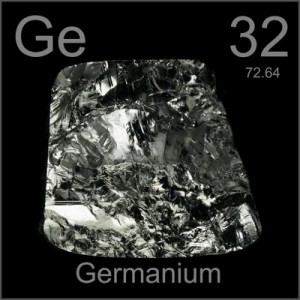Germanium
Germanium is element 32 in the periodic table. It is not a flower (that is geranium!), but was named for Germany where it was first identified. It has a chemistry in the ocean that is much like Si, but it is a million times less abundant.  However, there are a few important differences. It is not an essential element for organisms, but it is interesting because we hope to use its behavior to learn more about the Si cycle. One new approach we are trying, is to study the ratios of the isotopes of Ge. For example, most germanium atoms have 32 protons and 42 neutrons (this would be Ge-74, with 74 representing the sum of protons and neutrons), but some atoms of Ge may have different numbers of neutrons. For example, Ge-70 has only 38 neutrons (as 32+38=70). There are 5 stable isotopes of Ge, and they seem to have slightly different ratios in Ge that comes from different sources. Some Ge is added to the ocean by weathering rocks, some is added by the inflow of hydrothermal fluids from high temperature ridge systems, and some is simply recycled by dissolving the tests of diatoms (see notes about Si). We think these have different ratios of the stable Ge isotopes, but do not yet know why.
However, there are a few important differences. It is not an essential element for organisms, but it is interesting because we hope to use its behavior to learn more about the Si cycle. One new approach we are trying, is to study the ratios of the isotopes of Ge. For example, most germanium atoms have 32 protons and 42 neutrons (this would be Ge-74, with 74 representing the sum of protons and neutrons), but some atoms of Ge may have different numbers of neutrons. For example, Ge-70 has only 38 neutrons (as 32+38=70). There are 5 stable isotopes of Ge, and they seem to have slightly different ratios in Ge that comes from different sources. Some Ge is added to the ocean by weathering rocks, some is added by the inflow of hydrothermal fluids from high temperature ridge systems, and some is simply recycled by dissolving the tests of diatoms (see notes about Si). We think these have different ratios of the stable Ge isotopes, but do not yet know why.
One of the projects on this cruise is to determine how large the isotopic ratio differences are for Ge from different sources, and why they vary. If this is successful, we can then study germanium isotope ratios in sediments from the past to determine how weathering, hydrothermal flow, or the oceanic recycling of Si may have differed as the earth’s climate has varied.
Written by Dr. Doug Hammond


Recent Comments